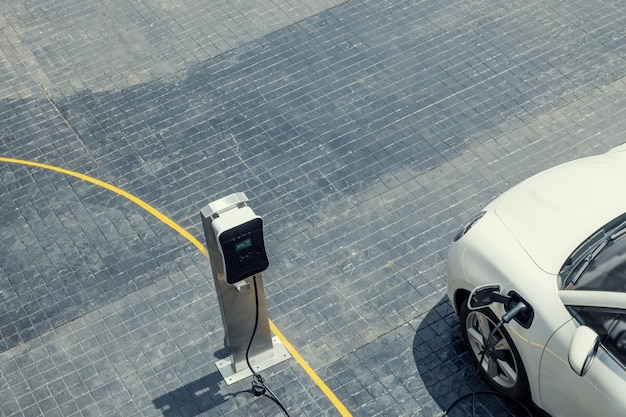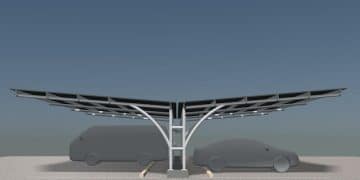Electric Vehicle Charging: How the Infrastructure Bill Will Impact US

The Infrastructure Investment and Jobs Act allocates significant funding to expand the electric vehicle charging network across the United States, aiming to accelerate EV adoption and reduce range anxiety.
The **new Infrastructure Bill** is poised to revolutionize electric vehicle charging stations across the United States, paving the way for a more sustainable and accessible future for EV drivers. But what exactly does this mean for you?
The Infrastructure Bill: A Roadmap for EV Charging Stations
The Bipartisan Infrastructure Law, officially known as the Infrastructure Investment and Jobs Act, represents a monumental investment in America’s infrastructure. A significant portion of this investment is dedicated to accelerating the transition to electric vehicles (EVs). This includes substantial funding for the development and expansion of a nationwide network of EV charging stations. The aim is to make EV ownership more convenient and accessible, addressing key barriers to adoption such as range anxiety and the availability of charging infrastructure.
This bill isn’t just about throwing money at the problem; it’s a strategic plan to create a robust and reliable charging network that can support the growing number of EVs on the road. By focusing on strategic investments and public-private partnerships, the Infrastructure Bill seeks to ensure that the transition to electric vehicles is equitable and benefits all Americans.

Funding Breakdown: Where the Money is Going
Understanding how the Infrastructure Bill allocates funds is crucial to grasping its potential impact. This isn’t just a general allocation; the bill includes specific programs and initiatives designed to target different aspects of EV charging infrastructure development. Let’s break down where the money is going.
The National Electric Vehicle Infrastructure (NEVI) Formula Program
A significant portion of the funding is allocated through the NEVI Formula Program. This program provides funds to states to strategically deploy EV charging infrastructure along designated Alternative Fuel Corridors. These corridors are major highways and interstates that will be equipped with charging stations at regular intervals, ensuring that EV drivers can travel long distances with confidence.
Competitive Grant Programs
In addition to the NEVI Formula Program, the Infrastructure Bill also establishes competitive grant programs. These programs provide funding for projects that go beyond the basic requirements of the NEVI program, such as innovative charging technologies, community-based charging solutions, and projects that promote equitable access to EV charging.
- Rural Charging Expansion: Funds dedicated to expanding charging access in rural areas, addressing the unique challenges of long distances and limited infrastructure.
- Community Charging Initiatives: Grants for projects that focus on providing charging solutions in underserved communities, ensuring that the benefits of EV adoption are shared by all.
- Advanced Charging Technologies: Support for the development and deployment of cutting-edge charging technologies, such as ultra-fast charging and wireless charging.
The allocation of funds through both formula programs and competitive grants ensures that the Infrastructure Bill addresses a wide range of EV charging needs, from basic infrastructure development to innovative solutions that can accelerate the transition to electric vehicles.
Boosting EV Adoption: Overcoming Range Anxiety
One of the primary goals of the Infrastructure Bill’s investment in EV charging stations is to alleviate range anxiety. Range anxiety is the fear that an electric vehicle will run out of battery power before reaching a charging station. This concern is a major barrier to EV adoption, particularly for drivers who frequently travel long distances or live in areas with limited charging infrastructure.
By strategically deploying charging stations along major transportation corridors and in urban centers, the Infrastructure Bill aims to create a seamless and reliable charging experience for EV drivers. This will not only reduce range anxiety but also make EV ownership a more practical and convenient option for a wider range of consumers.

Public-Private Partnerships: A Collaborative Approach
The Infrastructure Bill recognizes that building a nationwide network of EV charging stations is a complex undertaking that requires collaboration between the public and private sectors. Public-private partnerships (PPPs) are a key component of the bill’s strategy. PPPs leverage the expertise and resources of both government agencies and private companies to accelerate the deployment of EV charging infrastructure.
These partnerships can take many forms, from government agencies providing funding and land for charging stations to private companies designing, building, and operating the stations. By working together, the public and private sectors can overcome the challenges of building a nationwide charging network more efficiently and effectively.
Benefits of Public-Private Partnerships
- Risk Sharing: PPPs allow the risks associated with EV charging infrastructure development to be shared between the public and private sectors.
- Access to Expertise and Resources: PPPs bring together the expertise and resources of both government agencies and private companies, leading to more innovative and efficient solutions.
- Accelerated Deployment: PPPs can accelerate the deployment of EV charging infrastructure by streamlining the planning, permitting, and construction processes.
The success of the Infrastructure Bill’s EV charging initiatives hinges on the ability of government agencies and private companies to work together effectively. By fostering collaboration and innovation, PPPs can help to build a robust and reliable charging network that supports the widespread adoption of electric vehicles.
The Impact on Communities: Jobs and Economic Growth
Beyond its environmental benefits, the Infrastructure Bill’s investment in EV charging stations is expected to have a significant positive impact on communities across the United States. The construction, installation, and maintenance of charging stations will create jobs in a variety of sectors, from manufacturing and construction to electrical engineering and software development.
Moreover, the increased adoption of electric vehicles can lead to economic growth by reducing reliance on imported oil, supporting domestic manufacturing, and fostering innovation in the EV industry. Communities that embrace EVs and invest in charging infrastructure can position themselves as leaders in the clean energy economy.
Economic Benefits of EV Charging Infrastructure
- Job Creation: The development and deployment of EV charging stations will create jobs in construction, manufacturing, and technology sectors.
- Reduced Energy Costs: EVs can reduce energy costs for consumers and businesses by lowering fuel expenses and reducing reliance on fossil fuels.
- Economic Growth: A thriving EV industry can stimulate economic growth by attracting investment, fostering innovation, and creating new business opportunities.
The Infrastructure Bill’s investment in EV charging stations is not just about building a cleaner transportation system; it’s also about creating jobs, promoting economic growth, and building a more sustainable future for communities across the United States. It’s a forward-thinking approach that recognizes the interconnectedness of environmental sustainability and economic prosperity.
Challenges and Opportunities: Ensuring Equitable Access
While the Infrastructure Bill represents a significant step forward in promoting EV adoption, there are still challenges to overcome. One of the most important is ensuring equitable access to EV charging infrastructure. Not all communities have the same access to charging stations, and this disparity could widen the gap between the haves and have-nots in the transition to electric vehicles.
Addressing this challenge requires a focus on deploying charging stations in underserved communities, providing incentives for low-income individuals to purchase EVs, and ensuring that charging infrastructure is accessible to people with disabilities. By prioritizing equity, the Infrastructure Bill can help to ensure that the benefits of EV adoption are shared by all Americans.
| Key Aspect | Brief Description |
|---|---|
| 💰 Funding Allocation | Bill invests significantly in EV charging infrastructure through NEVI and competitive grants. |
| ⚡️ Addressing Range Anxiety | Strategic deployment of charging stations along major corridors to boost consumer confidence. |
| 🤝 Public-Private Partnerships | Collaboration between government and private companies for efficient infrastructure development. |
| 🧑🤝🧑 Community Impact | Job creation, reduced energy costs, and economic growth for local communities. |
Frequently Asked Questions
▼
The Infrastructure Bill allocates billions of dollars specifically for electric vehicle charging infrastructure, primarily through the NEVI Formula Program and competitive grants.
▼
The NEVI Formula Program provides funds to states to deploy EV charging infrastructure along designated Alternative Fuel Corridors, ensuring nationwide coverage.
▼
By strategically placing charging stations along major highways, the bill aims to make long-distance EV travel more reliable and convenient for drivers.
▼
Yes, the construction, installation, and maintenance of charging stations will create new jobs in various sectors related to electric vehicle infrastructure.
▼
The bill prioritizes deploying charging stations in underserved communities and provides incentives for low-income individuals to purchase electric vehicles.
Conclusion
The Infrastructure Bill’s investment in electric vehicle charging stations marks a pivotal moment in the transition to a cleaner, more sustainable transportation system. By addressing key barriers to EV adoption, such as range anxiety and the lack of charging infrastructure, this bill paves the way for a future where electric vehicles are accessible to all Americans, driving economic growth and promoting environmental sustainability.





